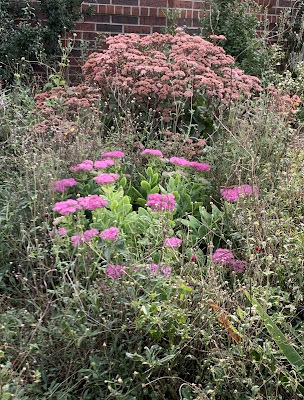Ah, Bluebird house maintenance! I'm a little early this year running my bluebird trail. Normally, I'm doing this on a cold day in late November or early December, but I'll take the high 60's and sunshine anytime. I skipped the bluebird trail last year entirely so it was doubly important that I get out there and clean house, so to speak, this year; clean house after house, after house and after house, twenty-four houses in all spread over my 20 acres and overlooking all the neighbors.
I always start out loaded down with screwdrivers and wire and nails and wood screws and a hammer and wire cutters, because every year a house will need its roof repaired or the house need to be held tighter against a post. I've learned, over the years, that paper wasps also like these boxes, some designs more than others (I think my newer house design had less paper wasps this year). Bluebirds aren't harmed by the wasps but don't like to nest in houses with wasp nests, so I always carefully remove the wasp nests from every home. I just read today that rubbing a bar of soap on the inner ceiling of the birdhouse will deter the wasps, so I'll have to try that next year.Some of my bluebird houses are getting quite old, showing gray weathered wood and splintered sides. I believe I made the box above more than 10 years ago and from this closeup, you can see the patina and lichens it has accumulated, character and wisdom from the Kansas seasons. It may look ancient and rundown, but it still housed a nest last year and that's what counts.
Bluebirds aren't the most fantastic nest architects on the planet, a thin bed of grass is about all they place in the box, but it seems to do the trick. I was really proud this year of the results of my NABS-approved Roush Bluebird Nestbox; twenty unmistakable bluebird nests, 20 nests in of 24 boxes, a personal best. Or rather a personal best of my bluebird tenants. I attribute the increased count to moving some of the boxes that previously attracted wrens to other areas away from the woods. Two of the four remaining boxes had anemic nests that I didn't count, perhaps occupied a year ago, or perhaps there was trouble during the nest-building. Who knows? A snake reaching a box in the summer, a jilted male bluebird without a mate, or another bird attempting to move in. Maybe next year, with the new porch and straightened shutters of my repairs, some poor lonely male bluebird will have a better chance to attract a mate. Hope springs eternal in the rusty breast of a bluebird.PS: I found that the links to the Roush NABS-approved Bluebird Nestbox don't work in the original post as linked above, so I placed them on a separate page here in the blog. Look at the top for the "Bluebird House/Presentations" tab!












